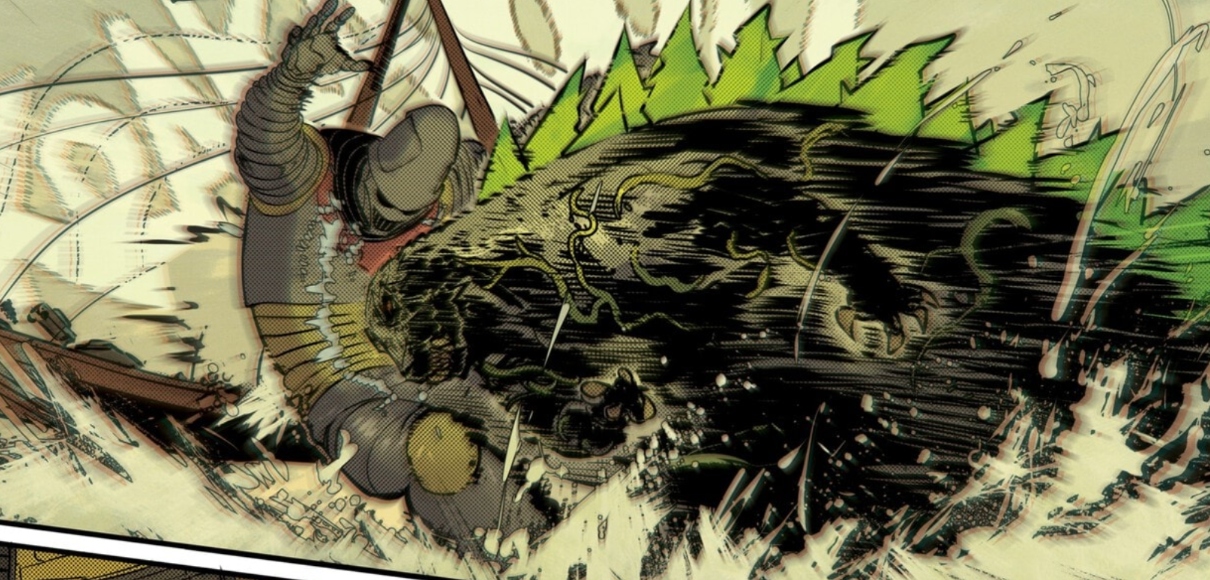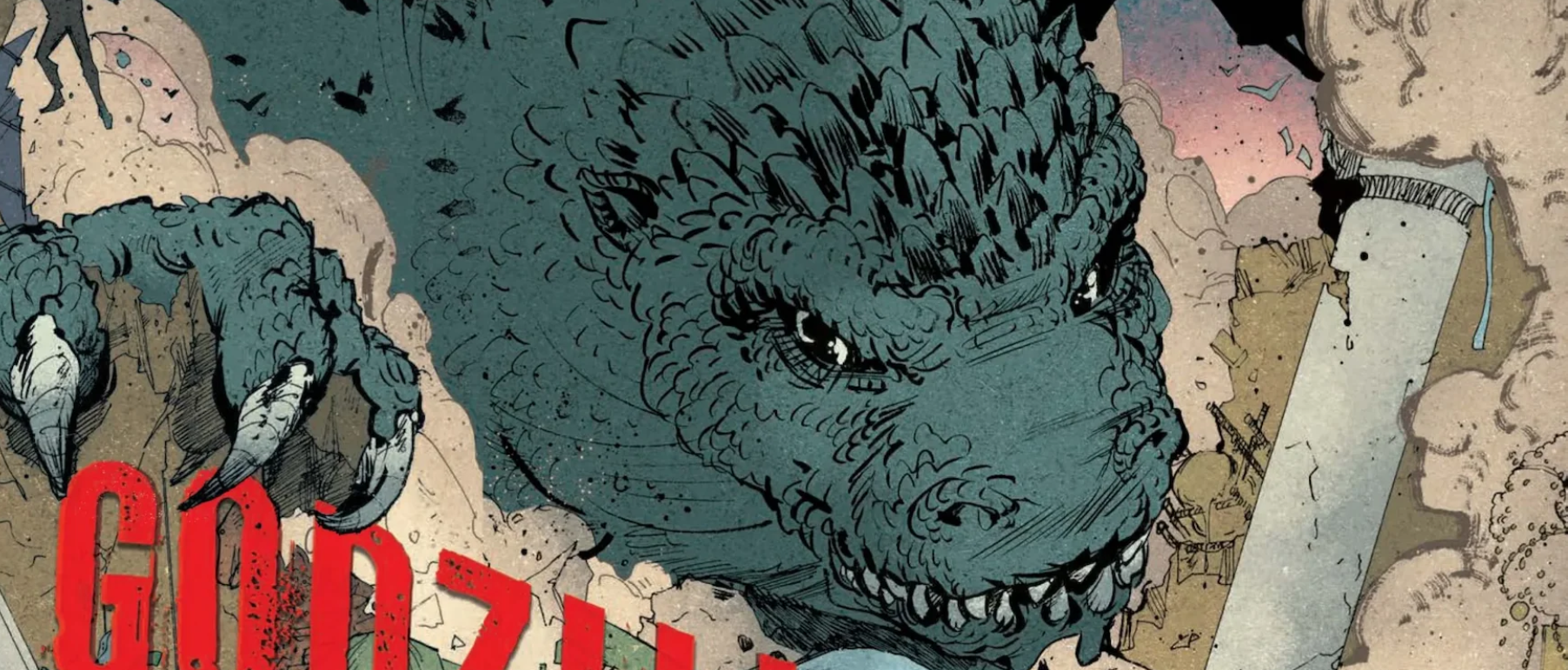I have a… let’s say, complicated relationship with the Meg franchise.
Back in 2018, I didn’t have too much interest in The Meg, the first entry in the series. I was planning on seeing it, of course, but it wasn’t a high priority compared to other releases from that year. True, it was a giant shark movie; a big enough shark that it could be considered a kaiju film. But as I started talking with some friends and coworkers about it, interest grew exponentially, to the point where, when we finally went to see it, we had booked seven seats in the theater for it, well over $100. I think that added to the experience of it on its own… because, well, we’ll get there.
Fast forward to just a few months ago, on Talking Toku, we decided to revisit The Meg in the lead up to its sequel. To give ourselves some new perspective on it, we decided to all read Steve Alten’s original novel, MEG: A Novel of Deep Terror. The general consensus was that, while the book was surprisingly enjoyable and wears its Jaws influences on its sleeve as a source of pride, Jon Turteltaub’s film didn’t quite hit the mark. For me personally, it encapsulates everything wrong with how Hollywood adapts most novels in the modern day. Jonas Taylor, the main character, is now no longer an aging, disgraced scientist on the verge of a messy divorce, but rather an extremely capable, happy and handsome Jason Statham. I appreciated the direction they tried to take it in, but it didn’t quite do it for me at all.
But, when the trailer for its sequel, Meg 2: The Trench finally dropped, I had hope once more. It seemed like it wasn’t taking itself seriously in the least now. (The trailer literally shows Jonas riding a jetski up a wave to spear a Megalodon.) I like Ben Wheatley as a director, and overall, it seemed like it would at least be an enjoyable time. As such, we went into overdrive with the memes. I changed my profile picture to the titular shark from the film. We made a small Discord server that was entirely Meg-themed, with channels such as “the-trench,” “pictures-of-the-meg,” and the voice channel, “Jonas Taylor’s Cuck Shed.” We’d fawn over anything even remotely shark-related. I started playing Maneater again. We probably had more fun joking about the film than we did with either of the films.
However, I also made the conscious decision to read the source material again before seeing the movie, and that little bit of doubt crept into my mind again. Judging by the trailer, the film was going to have little to no narrative similarities with The Trench, aside from the actual Mariana Trench itself playing a part. But I stayed positive. I wanted to go into the film with as open a mind as I could.
And so I did, even with the abysmal reviews that surrounded it. Months of waiting and joking all led to the one moment, where I sat down to watch Meg 2: The Trench. And when all was said and done, I thought… “Yeah, okay.” Some spoilers ahead!
Don’t get me wrong, I would not consider this a “good” film, far from it. From a purely critical point of view, it’s pretty terrible. The Trench, like its predecessor before it, features a notably messy script. The sequel opens on a scene set in the Cretaceous period, featuring a megalodon devouring a large theropod dinosaur, most likely a Tyrannosaurus Rex in a scene reminiscent of the opening of the first novel. However, instead of using this scene to transition into the larger plot, it doesn’t actually have a reason to exist aside from “It’s just like that scene in the book! That’s my favorite scene in the whole entire book!” We then pick up with Jonas five years removed from the previous, now working as an ecoterrorist, but still helping a small chunk of the cast from the first film explore the Mariana Trench, as well as looking after Meiying, now at the rebellious age of 14, since the off-screen unceremonious death of her mother Suyin,
In their travels into the trench, their ship, Mana One, has managed to capture a megalodon pup, Haiqi, and has been raising her in captivity. The where and why of Haiqi’s existence is not important. Once again, it feels like a case of “Well, this was in the book, so we have to have it in the movie.” However, whereas Haiqi’s novel counterpart, Angel, is directly involved with the plot, and even connects back to the first book (being the offspring of the main shark), Haiqi is just… Kind of there, and serves little purpose other than to serve as tension for Jiuming, the estranged brother of Suyin, and thus, Meiying’s uncle. In fact, after the crew enters the trench, Haiqi is seemingly completely forgotten until quite literally the very end as one final hiccup before everyone lives happily ever after (until M3G?).
During one of these expeditions down into the trench, Jonas and crew come across a rogue mining operation that has been organized by Jiuming’s business partner, Hillary Driscoli, serving as the film’s significantly less evil and therefore less interesting version of the novel’s Benedict Singer. Unfortunately, the similarities between book and movie end here. Jonas faces off against Montes, a mercenary hired by Driscoli, with whom he shares some history with, but it’s barely important. The film wants us to believe that this is Jonas’ arch-enemy or something, but Montes is never developed enough as a character to be anything more than a slightly more important goon.
This is one of the film’s biggest issues: While all the returning characters have great chemistry together, and are fun to watch (Jonas and Meiying’s relationship is even more sweet this time around, as he’s become a legitimate father figure), nearly all of the new additions have about the same presence as any of the various fish seen in the background during an underwater scene. They’re only there for shark bait, and I couldn’t even tell you a single one of their names.
Montes blows the whole mining operation in an attempt to kill Jonas and company, accidentally opening a very large hole in the thermocline, allowing three enormous Megalodons as well as a downright enormous octopus, to breach the surface. This is also where we’re introduced to the Snappers; ugly, aquatic lizards that are a major step down from the novel’s antagonistic Kronosaurus. They work better in an action film than a large marine reptile, but it’s hard to ignore how poorly designed the creatures are to live that deep underwater. The Snappers are present during the Cretaceous prologue, presented as amphibious creatures. However, it seems as though millions of years of evolution has NOT caught up to them, and they are perfectly capable of walking on land as well as sea in the present time. Conversely, Alten goes on to explain in the novel that the Kronosaurus evolved gills to be able to breathe underwater indefinitely, rather than typical marine reptiles that still need air to breathe. Not to mention they personally call to mind those weird four-legged things from 65 earlier this year.
This sequence, within the underwater mining rig, is also where we see Jonas Taylor break the laws of physics in an absolutely baffling display. For reasons that, to me, are still unclear, Jonas has to exit the rig and swim freely without any gear. At 25,000 feet down below sea level. It is explained how he can do this without dying instantly, yes. But it isn’t what I would call a satisfactory or believable answer. Unless you subscribe to the theory that Jason Statham is simply Built Different™, which is perfectly acceptable.
Thankfully, the team finds a way out of the trench, and heads back up to the relative safety of Mana One. They arrive to find it overtaken by Driscoli’s mercenaries, as there was a mole on the base the entire time, but this plot point is presented in such an uninteresting way, it’s hard to care. Surprise! It was the new character all along. This is also more or less where the plot gets shafted. It’s all action from here on out, to the point where it almost feels like a different movie, one more suited to Wheatley’s creative direction than the first half. It’s fitting, as most of this back half takes places on a resort called Fun Island, which, given the sudden presence of three massive prehistoric sharks, the Snappers, AND a giant octopus, seems anything BUT fun for anyone vacationing there.
The highlight of this film IS Wheatley’s direction here, he has a really fun, snappy sense of style when it comes to action scenes (look no further than Free Fire from 2016 for evidence of this). It’s not unlike that of his fellow Brit, Edgar Wright. One of the most interesting shots in the film is even in the trailer; a POV shot from inside of one of the meg’s mouths as it chomps down on tourists. It’s much more effective on the big screen than it was in the trailer.
There’s some other fun stuff here; Jonas gets an eye-rolling yet still smile-inducing one-liner; the jetski battle from the trailers (sans the “Barracuda” needle-drop); even a small kaiju battle between the last surviving megalodon and the giant octopus, which doesn’t last nearly as long as it should have in a movie like this. Which is what the entire movie feels like. It feels like there should have been more. The entire film feels like it was written with nothing but half-measures in mind. Would it have been better if it had committed to the bit? Probably not, but it might’ve been a bit more enjoyable. It’s a shame, it seemed like most people were expecting the whole movie to be like the third act, and based on the trailer, that’s not entirely unreasonable. Maybe Ben Wheatley wasn’t the right person to direct this film. Or maybe it needed a bigger budget. Or, more likely, it just needed a better script. Maybe one day we’ll get a halfway decent Meg film. But, as the co-creator of Meg Monday, it pains me to say; that day is not today.





